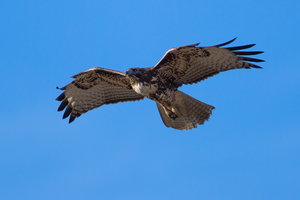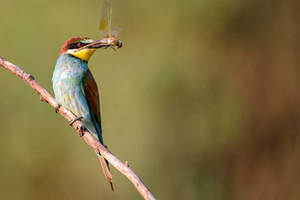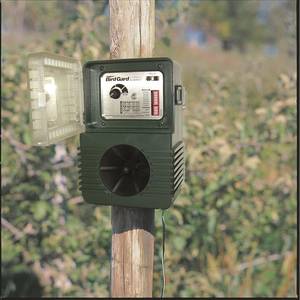In this article, we will explain how to repel bee-eaters. Bee-eaters cause significant problems and economic losses for our beekeepers. But before learning how to combat bee-eaters, it is essential to better understand the habits of this beautiful bird:
- The European Bee-eater
- Habitat of the bee-eater
- Feeding of the bee-eater
- Predators of the bee-eater
- Migration Months of the European Bee-eater
- The European Bee-eater, a protected bird
- Bees and Bee-eaters. Impact of the Bee-eater on the beekeeping sector
- How to deter bee-eaters
Important Facts to Know about the Bee-eater
The bee-eater (Merops apiaster) is a very beautiful bird. It has striking colors, a curved beak, and pointed wings.
Feeding of the Bee-eater
Its name in English is “Bee Eater,” and indeed, the bee-eater primarily feeds on bees that it catches in flight. But it also feeds on other flying insects such as wasps, flying ants, dragonflies, etc.
To hunt, bee-eaters often perch on dry branches of trees or on power lines. From that position, they spot their prey and catch them in flight. As we can see in the following video, the bee-eater perches on branches to eat its prey. But before consuming it, it hits it against the branch to remove the stinger.
Habitat of the Bee-eater

Bee-eaters are social birds. This means that they live in colonies consisting of several individuals.
Bee-eaters create their nests by excavating tunnels in the sand. It is common to find bee-eater nests on the sandy banks that form on the sides of rivers. Bee-eaters tend to return to the same place every year to nest and usually lay between 2 and 9 eggs.
Therefore, if you saw bee-eaters in the area last year, it is likely that they will return this year to nest in the same place. They usually prefer cultivated areas near rivers, which are perfect for building their nests. They also prefer areas that are not heavily forested, with sparse trees or scattered shrubs.
Predators of the Bee-eater
Natural predators of the bee-eater include raptors such as the peregrine falcon, sparrowhawk, and goshawk… Bee-eaters have an innate fear of these raptors. If any of these raptors are flying in the area, bee-eaters will not approach until the danger has passed.
Migration Months of the Bee-eater

The bee-eater migrates from Africa to southern Europe: Spain, Portugal, France, and Italy during the summer months. The first bee-eaters usually arrive at the end of May and are present during the months of June, July, August, and September. With the arrival of the first cold weather in September, bee-eaters return to the warmer climates of Africa.
In Spain, the bee-eater has a greater impact on the regions of Andalusia, Extremadura (which has the highest concentration of registered beehives nationwide), Palencia, Guadalajara, and Aragon (Huesca). The presence of bee-eaters in the Huesca area is higher in late August and September.
The Bee-eater, a Protected Bird
The bee-eater is a protected bird listed in the National Catalog of Endangered Species. Therefore, it is crucial to know how to deter bee-eaters and what methods we can and cannot use.
Bees and Bee-eaters. Impact of the Bee-eater on the Beekeeping Sector

Beekeeping is a sector of great importance, not only economically but also as an environmental tool. However, the European Bee-eater is causing significant economic damage to beekeeping operations.
The damage caused by the European Bee-eater to beehives is not only that bee-eaters eat bees, including worker bees and drones. Bee-eaters seem to prefer larger queen bees that they hunt during their slow nuptial and mating flights. This poses a great risk to the viability of the colony since queen bees lay over 1,000 eggs per day.
However, as mentioned earlier, the issue with bee-eaters is not only that they eat bees. Another significant problem with bee-eaters is that they prevent bees from going out for foraging and collecting nectar from flowers. If the bees sense the presence of a perched bee-eater near the hives or hear its distinctive call, they avoid leaving the hives. This leads to poor ventilation of the hives and can result in the death of the colony.
How to Repel Bee-eaters
The European Bee-eater is a protected bird in Europe, listed in the National Catalog of Endangered Species. Therefore, it is essential to know how to deter bee-eaters and which methods we can and cannot use. Some methods may be prohibited or ineffective.
Methods We Should Not Use to Deter Bee-eaters – Prohibited Methods
The European Bee-eater is a protected bird. It cannot be killed or captured as it is at risk of dying. This means that we should not use shotguns, poisons, nets, capture devices, or any other means that may cause harm or death to bee-eaters.
Methods We Should Not Use to Deter Bee-eaters – Ineffective Methods
We advise against using ultrasonic bird repellers to deter bee-eaters. These ultrasonic bird repellers are practically inaudible to humans and completely ineffective in repelling bee-eaters.
We also discourage the use of static visual bird repellerss such as owl figures that are stationary and have little or no movement. Their effectiveness, if any, is very limited over time. After a few days, bee-eaters become accustomed to these figures, and they become ineffective.
Recommended Methods to Repel Bee-eaters
As mentioned earlier, some natural predators of the bee-eater are raptors such as falcons, hawks, and goshawks.
Falconry Services

Falconry services, which involve intimidation flights with birds of prey, are often effective in detering bee-eaters. Bee-eaters will not approach the area as long as the threat persists. However, there are two main drawbacks to these falconry services:
- On one hand, their cost. These services are quite expensive for most beekeepers. They are more suitable for professional beekeepers where the economic return justifies hiring a falconry service.
- On the other hand, their effectiveness is limited over time. In other words, a single intimidation flight during the season is not enough. To be effective, the raptor must fly in the area with certain frequency.
Falcon Kite Scarecrow to Repel Bee-eaters
A good alternative to avoid the high costs of falconry services is to use the Falcon Kite Scarecrow. Let’s see how it works:
- The Falcon Kite Scarecrow simulates the presence of a flying falcon in the area.
- The device consists of a telescopic mast that is anchored to the ground near the beehive area and is highly visible.
- The telescopic mast is available in two sizes: 5 meters and 7 meters in height. Whenever possible, we recommend using the 7-meter mast as it allows the falcon kite to fly higher, making it more realistic and therefore more effective.
- The kite that simulates a falcon is attached to the top of the mast. It has a range of realistic colors. The device is designed to lift off and simulate the presence of a falcon in the area with even a gentle breeze.
And it works! The Falcon Kite Scarecrow has proven to be effective, even in deterring larger birds such as seagulls. It provides coverage of approximately 700 square meters.
Tips on how to deter bee-eaters using the falcon kite:
- It is crucial that the falcon kite is as realistic as possible. Avoid black-colored falcon kites as they are less realistic.
- The mast should be at least 5 meters in height, but 7 meters is better.
- The key to maintaining the effectiveness of the falcon scarecrow over time during the months when bee-eaters attack the beehives is to avoid leaving it in the same position constantly.
- It is recommended to change its position every few days (around every 5 or 6 days), always placing it in a visible location for the bee-eaters that perch near our beehive.
- Remove the falcon kite scarecrow if you notice that the bee-eaters are no longer in the area. Reinstall it if the bee-eaters attempt to attack the beehives again.
Don’t miss the next article if you need more information on how the falcon kite scarecrow works.
Repelling Bee-eaters. Bioacustic Bird Repellers
BirdGard Iberia offers a specific bioacustic bird repeller for deterring bee-eaters from beehives. This bee-eater repellers emits audible sounds that are a combination of:
- Hunting cries of different raptors that prey on bee-eaters: falcons, eagles, owls, etc.
- Electronic harassment sounds.
Unlike other Bird Gard bioacustic bird deterrents, which include distress calls of the birds to be deterred, the BirdGard bee-eater repeller does not include distress calls of these birds. Including distress calls would have the perverse effect we explained earlier. Bees would hear the distress calls of the bee-eater and believe that bee-eaters are in the area, causing them to stay inside the beehives.
The BirdGard bee-eater repeller emits sounds in a random pattern, different each time, at different frequency levels, and through different speakers. The interval of silence between sound emissions is also random. This randomness prevents bee-eaters from becoming accustomed to the BirdGard sounds.
There are different models of Bird Gard Bee-eater Repellers available based on the required coverage area:
- The BirdGard Pro model is the smallest, covering an area of 6,000m2.
- Next is the BirdGard Pro Plus model, which covers an area of 12,000m2.
- If you need even more coverage, there is the BirdGard Super Pro model, which covers an area of 24,000m2.
- Finally, the BirdGard Super Pro Amp model covers 12 hectares of land.
The falcon kite scarecrow is always a good complement to the sonic bee-eater deterrent. The presence of a falcon in the area, combined with its cries, creates a synergistic effect that increases the effectiveness of the solution.
Repelling Bee-eaters. Conclusions
- To deter bee-eaters in small beekeeping operations, install the falcon kite scarecrow.
- For professional beekeepers or when more coverage is needed against bee-eaters in larger beekeeping operations, install the BirdGard bee-eater deterrent.
- You can purchase both devices from the BirdGard Iberia online store and have them delivered to your doorstep.


